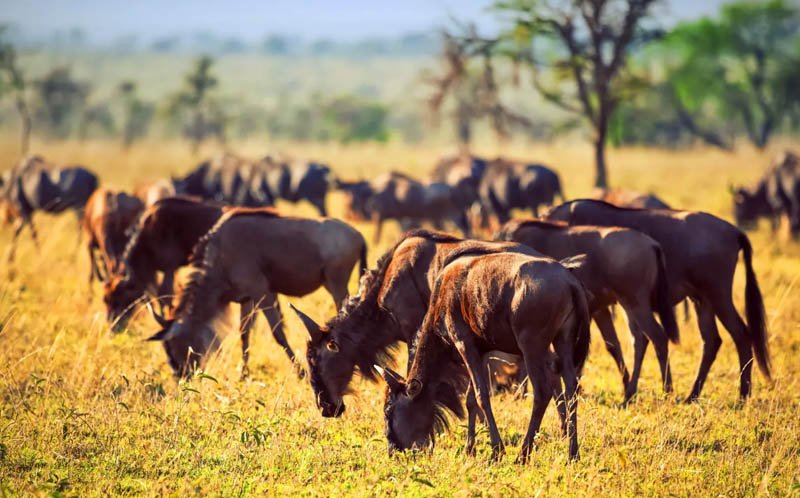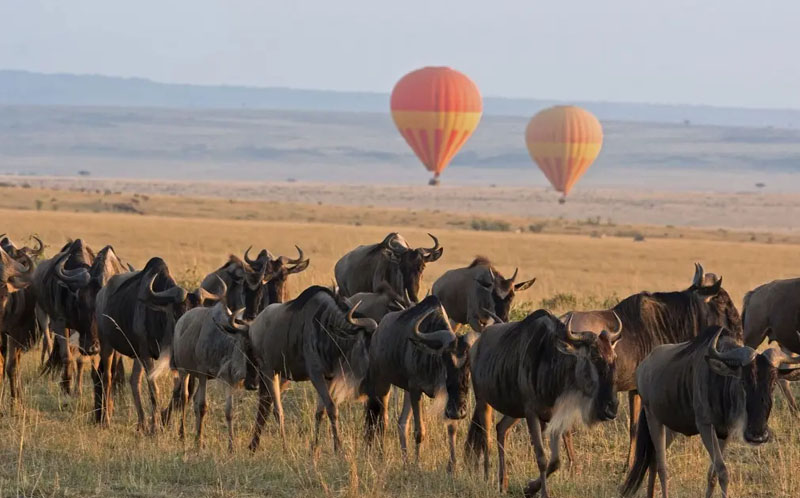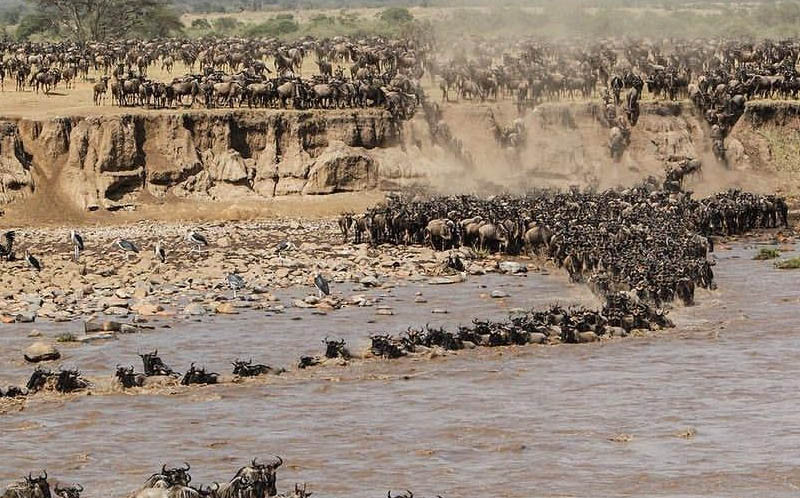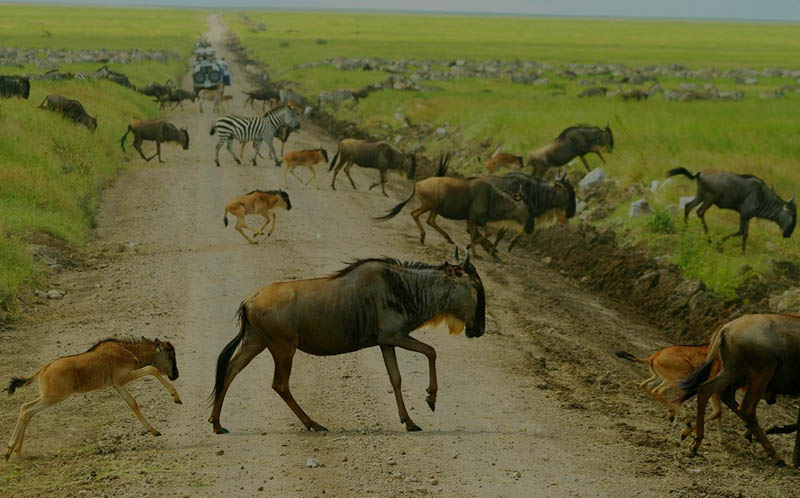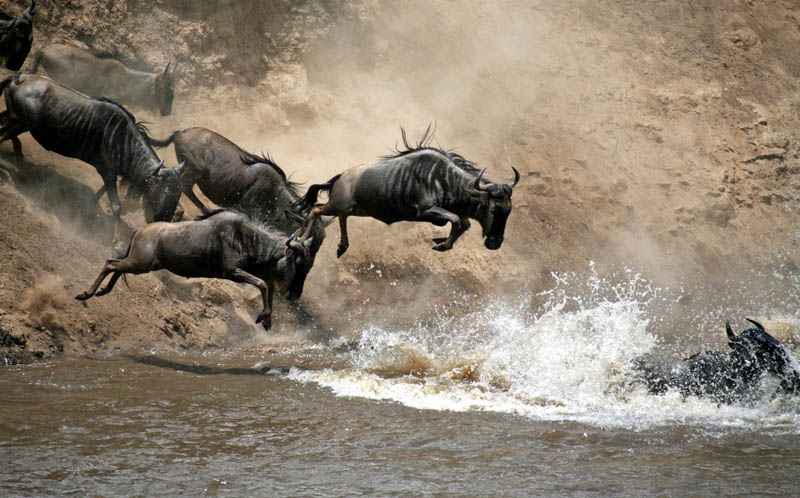Serengeti Migration Safari
Serengeti Migration Safari: Witness Nature’s Greatest Spectacle
The Serengeti Migration Safari is one of the most awe-inspiring wildlife experiences on the planet. Every year, over 1.5 million wildebeest, along with zebras and gazelles, embark on a massive journey across Tanzania’s Serengeti National Park and Kenya’s Masai Mara Reserve in search of fresh grazing lands. This epic event, known as the Great Migration, is a breathtaking display of nature’s rhythm, driven by seasonal rains and the never-ending struggle for survival.
The migration is a year-round event, with different highlights depending on the season. From the calving season (January–March), where thousands of wildebeest are born, to the dramatic Grumeti and Mara River crossings (June–August), where crocodiles lurk in the waters, every stage offers an unforgettable experience. As the herds move back south (October–December), the vast Serengeti plains become alive with action, making every safari moment truly remarkable.
A Serengeti Migration Safari is more than just a wildlife viewing experience—it’s a chance to witness the raw beauty of nature up close. Whether you stay in a luxury lodge, a mobile tented camp, or take part in a guided game drive, this adventure offers a unique opportunity to explore one of Africa’s most famous ecosystems and witness the greatest wildlife migration on Earth.
Serengeti Migration Luxury Safari Packages
Best time to see wildebeest migration
The best time to see the Serengeti Wildebeest Migration depends on which part of this spectacular journey you want to witness. From January to March, the herds gather in the southern Serengeti for the calving season, attracting predators like lions and cheetahs. Between April and June, they move northward, with dramatic river crossings starting in June and July at the Grumeti River. The most famous crossings at the Mara River happen between July and October, offering heart-pounding action as wildebeest face crocodile-infested waters. By November and December, the herds return south, completing their annual cycle. Each phase of the migration offers a unique and breathtaking experience!
1. Calving Season (January – March)
📍 Southern Serengeti (Ndutu, Ngorongoro Conservation Area)
- Thousands of wildebeest give birth.
- Best time to see predators (lions, cheetahs, hyenas) hunting.
- Lush landscapes with plenty of newborns.
2. Grumeti River Crossing (May – June)
📍 Western Serengeti & Grumeti Reserve
- The herds start moving north.
- First dramatic river crossings (not as intense as the Mara River crossings).
- Dry season begins, making game viewing easier.
3. Mara River Crossing (July – October) 🔥 (Peak Season!)
📍 Northern Serengeti (Tanzania) & Masai Mara (Kenya)
- Most dramatic crossings happen at the Mara River.
- Thousands of wildebeest and zebras attempt to cross crocodile-infested waters.
- Best chance to see large predators in action.
4. Return to Serengeti (November – December)
📍 Central Serengeti & Southern Serengeti
- Herds start migrating south from Masai Mara.
- Good time for less crowded safaris before the cycle starts again.
Best Time for Your Safari?
- July – October → Best for dramatic Mara River crossings.
- January – March → Best for calving & predator action.
- May – June → Great for fewer crowds & early river crossings.
Serengeti Migration Frequently Asked Questions (FAQs)
What is the Serengeti Migration?
The Serengeti Migration is the annual movement of millions of wildebeest, zebras, and gazelles across the Serengeti and Masai Mara ecosystems in East Africa. These animals travel in search of food and water, following a specific route dictated by the seasonal rains and the availability of grazing areas.
When does the Serengeti Migration occur?
The migration follows a year-round cycle, but the main movements occur from April to October. The animals begin moving north from the Serengeti towards the Masai Mara in Kenya around late June and return south around November after the rainy season.
Why do the Animals Migrate?
The animals migrate in search of fresh grazing grounds and water sources. The migration is primarily driven by the seasonal rains. As the rains fall in different areas, new grasses grow, providing a fresh food source for the herbivores.
What animals are involved in the Serengeti Migration?
The main species involved in the migration are:
- Wildebeest: The largest group, numbering in the millions.
- Zebras: Often travel alongside the wildebeest.
- Gazelles: Including Thomson’s and Grant’s gazelles, which also participate in the migration
How long does the migration last?
The migration is a continuous cycle and lasts year-round, with the animals making their journey across the Serengeti and Masai Mara. However, the most dramatic and well-known portions of the migration typically occur between April and October.
Where can you see the Serengeti Migration?
The best places to witness the migration include:
- Serengeti National Park (Tanzania): Especially in the southern and central Serengeti.
- Masai Mara National Reserve (Kenya): Best from July to October when the herds cross the Mara River.
- Ngorongoro Crater: Although not part of the main migration route, it is often home to migratory herds, particularly after calving season.
What is the Mara River Crossing?
The Mara River Crossing is one of the most dramatic parts of the migration, where vast numbers of wildebeest and other animals attempt to cross the river to reach the fertile grazing grounds of the Masai Mara. This crossing is perilous, with crocodiles waiting in the water and predators on the banks.
Can you witness the Serengeti Migration year-round?
While the migration is an ongoing cycle, certain times of the year are better for observing specific events. For instance:
- Calving season (January to March): The southern Serengeti is filled with newborn wildebeest, which attract predators.
- River crossing (July to October): The most dramatic part of the migration when animals brave the Mara River.
What makes the Serengeti Migration so special?
The Serengeti Migration is unique due to the sheer scale of animal movement. It is considered one of the greatest natural events on the planet, involving over 1.5 million wildebeest, along with hundreds of thousands of zebras and gazelles. The entire ecosystem is affected by the migration, and the sight of such large herds crossing vast landscapes is breathtaking.
How can you experience the Serengeti Migration?
- Safaris: The best way to see the migration is on a safari, with options for game drives, hot air balloon rides, or even walking safaris.
- Guided Tours: Specialized migration tours are available with expert guides who know the best times and locations for viewing the migration.
Let's start Planning!
Ready for Your Adventure?
Absolutely! Are you ready to embark on the adventure of a lifetime? Whether it’s witnessing the Serengeti Wildebeest Migration, conquering Mount Kilimanjaro, or exploring the wild beauty of Tanzania, Tanzania Migration Safari is here to make it happen.
Let’s start planning your dream safari and trekking experience today! 🚀🌍🐘
Where would you like to begin your journey? 😊

